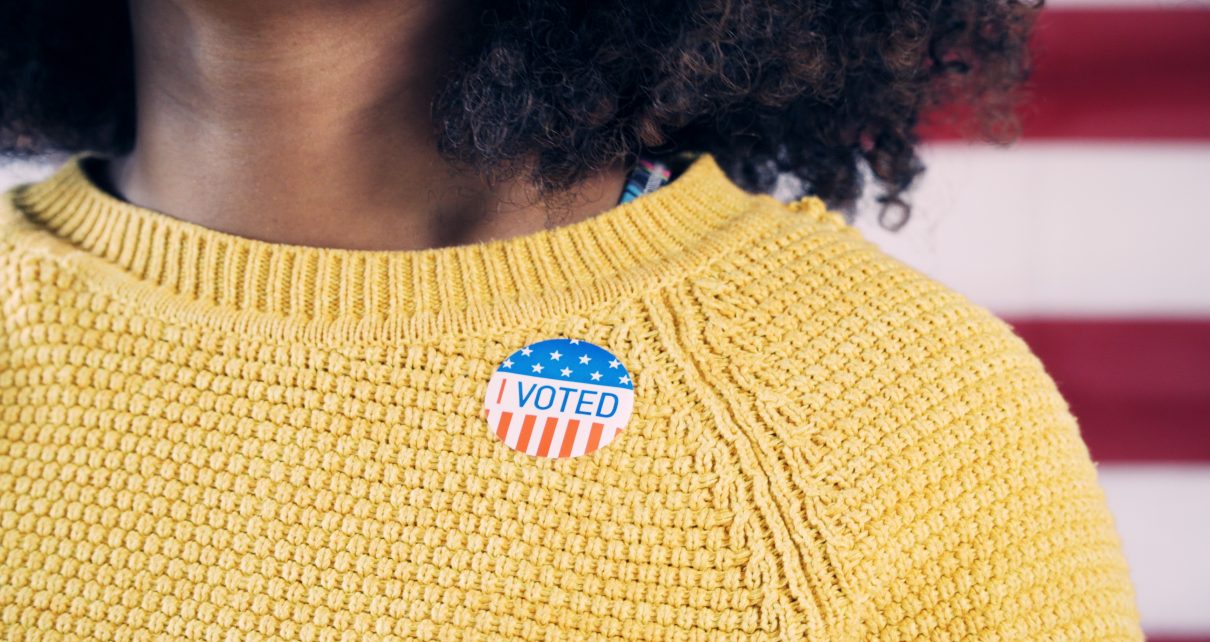
Young person wearing sticker after voting. (Photo: Made360/Shutterstock)
Just How Effective Was The Abortion Debate in The 2024 Election?
Has the impact of this hot button political issue diminished in just two years?
By Martin Marks, November 18, 2024 12:44 pm
I have written twice before at CaliforniaGlobe.com on perhaps the most divisive issue in our nation since slavery. That issue of course is abortion. Well before the landmark U.S. Supreme Court Decision Roe v. Wade was argued and published, the abortion debate raged and split the country on ideological grounds.
In 2022, a draft decision by the U.S. Supreme Court in the Dobbs v. Jackson Women’s Health Organization was leaked to the press which predictably caused a firestorm in the media, around business water coolers and across the nation’s kitchen tables. For too long, many in the nation wrongly believed that our judicial system was established to promote policy or the prevailing sentiment of the public at large. In The Courts Are No Place to Establish Policy, I reminded readers that the courts are not the place to champion the will of the people. Policy creation necessarily and constitutionally rests with the legislative and executive branches of government. It is then up to the courts to determine if that policy passes constitutional scrutiny.
Ultimately, that opinion was formally published, and the U.S. Supreme Court in Dobbs did not opine on the morality of, or need for abortion rights in the country but rather the constitutionality of lifting all restrictions on abortion on a federal basis which Roe v. Wade did. Instead, SCOTUS ruled that the abortion matter should be remanded to the legislatures and constitutions of the 50 states to establish appropriate law.
Predictably, the abortion issue became a political cudgel for the Democrats who relentlessly wielded it with aplomb and pounded their Republican opponents with it in the 2022 midterm elections. Those elections were previously anticipated to be a so-called Red Wave for the GOP as the Biden Administration had already experienced several failures and embarrassments, and the President himself was already showing signs of diminished cognitive abilities.
That Red Wave never materialized of course. In the second California Globe abortion piece I wrote, Republicans At A Crossroads On Abortion, I examined the impact of the abortion issue for the 2022 elections. Just ahead of the election the abortion issue did not show as prominently on voters’ minds in polling relative to other issues such as the economy and ever-soaring inflation. Pew Research showed The Economy as “very important” to 79% of voters. Several issues down the list came Abortion as “very important” to slightly more than half of voters at 56%. In some post-election exit polling, abortion evidently mattered to a much greater extent. Abortion as most important issue on voters’ minds rose to 27% while the economy/inflation dropped to 31%. This was nine-fold drop (36% to 4%) in the spread between the two issues. Obviously, the issue—relentlessly pounded home by Democrats—had its effect.
It wasn’t a farfetched prediction for me to forecast that Democrats would continue to use abortion as a wedge issue moving forward and it might just be time for Republicans to reassess on the matter if they wanted to win elections and recapture or maintain legislative majorities so they might prevail on other important issues.
So, what has transpired since 2022?
Before getting into the specifics, it is important to point out that the constitutional premise that the U.S. Supreme Court laid out in Dobbs began to take shape. Individual states began creating law through legislative action or through referendum–just as it should be.
In 2022 there were six states that were quick to place a referendum on the ballot with the purpose of either getting a sense of the public or enshrining an approach to abortion in their respective state constitutions. California, Michigan, and Vermont passed referenda that amended their state constitution to effectively prohibit government from interfering in any aspect of “reproductive freedom” including contraception and abortion. In Kansas and Kentucky, two reliable “red” states, voters rejected referenda that essentially would affirm that nothing in their respective state constitution creates a right to an abortion or requires the government to pay for same.
Perhaps most surprisingly, the voters of Montana—another reliably red state—narrowly rejected a ballot measure that would have established:
- that infants born alive at any stage of development are legal persons.
- requirement for medical care to be provided to infants born alive after an induced labor, cesarean section, attempted abortion, or another method.
- a $50,000 fine and/or 20 years in prison as the maximum penalty for violating the law.
In 2023 there was a lone referendum in Ohio that amended the state constitution to simultaneously allow citizens to “make and carry out one’s own reproductive decisions, including but not limited to decisions about abortion, contraception, fertility treatment, miscarriage care, and continuing pregnancy,” while at the same time “allow the state to restrict abortion after fetal viability, except when necessary to protect the pregnant patient’s life or health.”
In 2024 there were multiple referenda on state ballots that addressed abortion rights. On the surface, primary motivation was to hear directly from the voters on this contentious issue. Secondarily, Democrats sought to drive voter turnout strategizing that motivated abortion rights voters who otherwise might stay home on Election Day would come out and vote the entire Democrat ticket.
In Arizona, Colorado, Maryland, Missouri, Nevada, and NY voters backed a constitutional right to an abortion at various points during gestation. Three of these effectively overturned already-on-the-books state laws passed anticipating an overturn of Roe v. Wade, or more recently enacted policy in the wake of the Roe reversal.
After Montana rejected a 2022 referendum that would have protected born-alive infants, they returned to the ballot in 2024 to support a right to an abortion by referendum.
Voters in South Dakota, a state with one of the more restrictive abortion bans did not support a referendum that would have liberalized that law.
Nebraska voters had two competing referenda on the ballot and opted to maintain law restricting abortion.
In Florida, a majority of voters (57%) approved of an access to abortion ballot measure that would have liberalized the law restricting abortion to the first 6 weeks of pregnancy. However, it requires a 60% vote by voters to amend the Florida state constitution, so the measure failed. As an aside, let’s give credit where credit is due to Florida. First, it is hard to argue that the 60% threshold to amend the state constitution is not wise lest competing amendments ping pong back and forth on a yearly basis on closely contested issues. As a further off-topic aside, let’s give Florida credit for the timely tabulation and reporting of their 2024 votes. They have come a long way since the hanging chads of 2000.
As we now stand post-election 2024 there are a mosaic of state laws, many of which have been enshrined into state constitutions by direct vote of the people. They vary from total bans on abortion to restrictions based upon a gestational timetable, to no restrictions whatsoever. Keep in mind that there are many on both sides of the issue who are not happy with the state’s rights perspective that the U.S. Supreme Court backed and would prefer a federal law addressing abortion (pro or con) that would govern all 50 states. Short of an amendment to the United States Constitution, which is not likely to happen, a national law one way or the other governing abortion is not in the nation’s foreseeable future.
That said, it was a rallying cry of Democrats warning that a national total abortion ban is what Republicans would enact if given the majority and opportunity. That cry remains in the wake of Donald Trump’s election, GOP control of both houses of Congress, and a U.S. Supreme Court that without a doubt is now dominated by conservative thought. Prior to election 2024, candidate Donald Trump forcefully stated that he would veto any national abortion ban legislation and prefers to have the laws of the individual states continue to prevail.
Speaking of Mr. Trump and the Republicans, let’s take a look at the 2024 election and how that abortion issue might have affected results. Certainly—as I predicted without hardly going out on the proverbial limb—Democrats, from Kamala Harris on down the ballot, continued to play up reproductive rights as the hallmark of their campaigns. How’d that work out?
Just a few weeks prior to Election Day 2024, Pew Research issued their survey of voter priorities and predictably found that The Economy was very important to 81% of the electorate. This certainly holds true for most elections. Abortion once again was found several issues down the list as very important to just half the voters at 51%. This was 5% lower than just two years earlier, which might appear statistically insignificant yet, mathematically this was a comparative 5-point or 10% drop from 2022—perhaps enough to swing a close election.
Of course, we all know that not only did the Republican presidential candidate win the popular vote for the first time in 20 years, but the U.S. Senate was flipped to GOP control and Republicans appear to have marginally increased their slim majority in the House of Representatives. All this, of course, was occurring while most state abortion rights referenda were continuing to be approved by voters.
While there is no doubt many intertwining and complicated factors that led to a resounding Republican victory in 2024, It is safe to project that
- Many voters, while supporting access to abortion, “flipped” their votes and opted for Doanld Trump and down ballot GOP candidates.
- The reason for the above is that while abortion is important to many, there were not enough single issue abortion rights proponents to swing elections toward Democrats.
- Additionally, there were far more important issues on voters’ minds such as the economy and immigration that far outweighed any sentiment on the abortion issue.
- Democrats relied too heavily on promoting the abortion issue, and probably for good reason as voters viewed them as weak on the above-referenced economy and immigration.
Ultimately, the 2024 election was not a referendum on abortion, much to the chagrin of Democrats. They will no doubt continue an attempt to pound Republicans as opponents of women’s reproductive rights in subsequent elections. It remains to be seen whether Democrats will persist in promoting this issue primarily or begin to govern and then focus on issues far more important to a majority of Americans.
Republicans need to be aware that abortion politics still can sway close elections. Moving for a national ban on abortion in Congress, while seemingly the moral thing to do for some, would be ill-advised politically especially in light of Donald Trumps’ promise to veto such legislation.
The 2026 midterm elections are just ahead of us and those campaigns are already beginning. We’ll see just how the abortion issue plays. For sure, it’s not going away.
- Vice President Vance Visits The Golden State - February 22, 2025
- Is DEI Ready To DIE? - January 4, 2025
- Just How Effective Was The Abortion Debate in The 2024 Election? - November 18, 2024





I don’t understand what all the fuss either way is about concerning abortion among the regular folk. However, I think I have a clue about why the left is pushing it so hard, and it has nothing to with “reproductive rights” or “women’s health.” The leftist elite are all about snuffing the American national character. The fewer American babies, the fewer people who grow up with American notions. After so many abortions, women tend to become sterile. Children that have sex change operations become sterile. The border is thrown wide open, people who are used to corruption and bad treatment by their governments are arriving faster than they can be assimilated and as a group bring all the bad characteristics of their home countries with them, regardless how wonderful they may individually be. The left seeks to feed and house these people at citizen expense to make them dependent on the left. After a generation or so, America is fundamentally changed. New voters are just a part of the whole package of usefulness the “newcomers” are to elite leftist strategists. It sounds like a conspiricy theory, but it came directly to me, I didn’t get the notion from anyone else. Besides the far left planners are diabolical enough to think like this and distract everyone from the true nature of what they’re doing by pointing to the vague distance and yelling “squirrel” at the top of their lungs.
Great comment! Thank you for posting it.